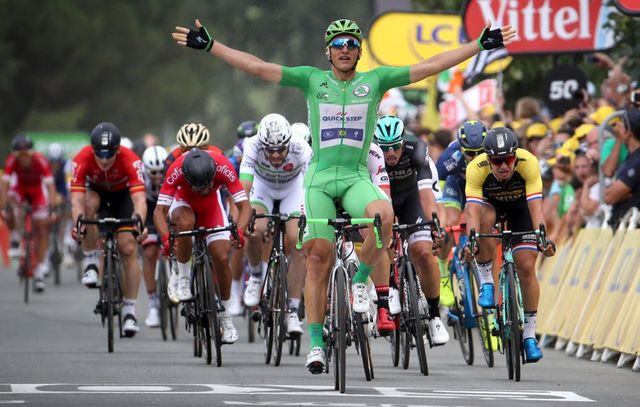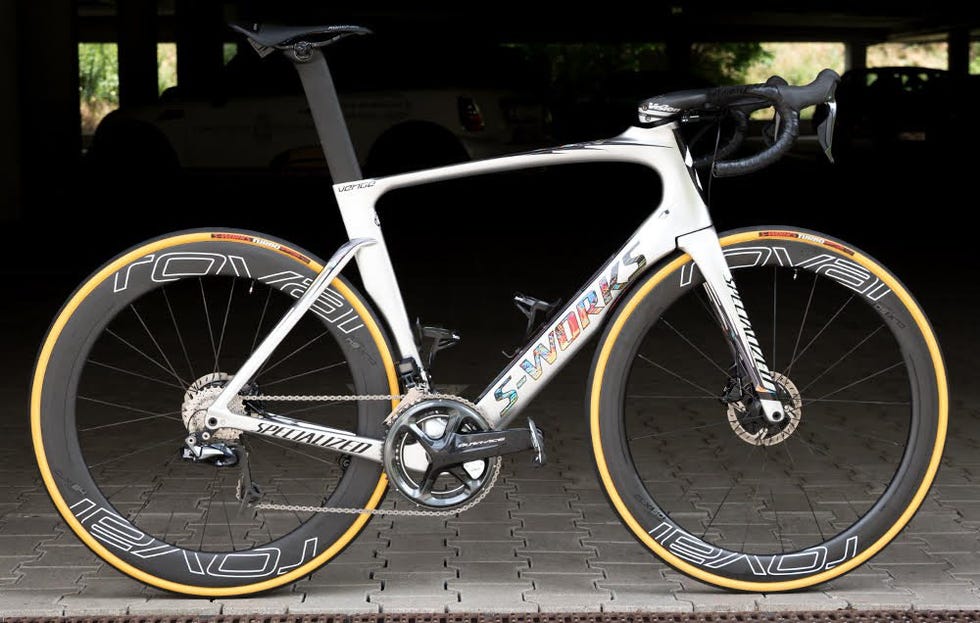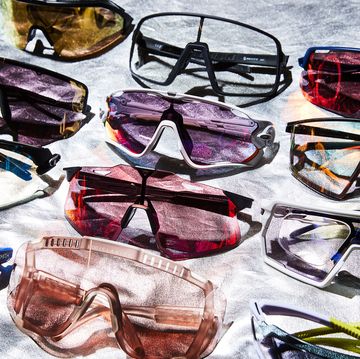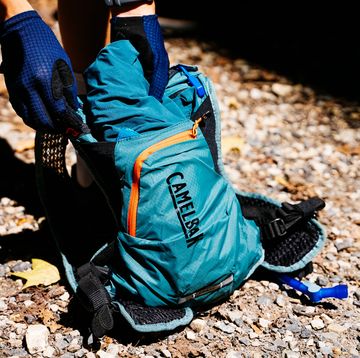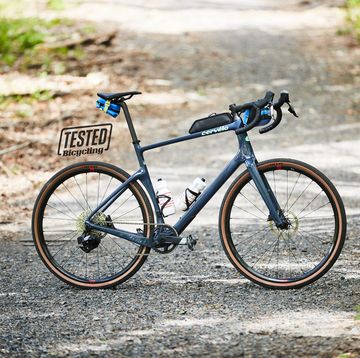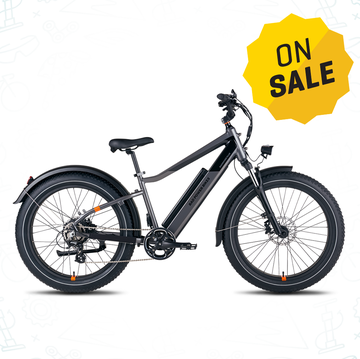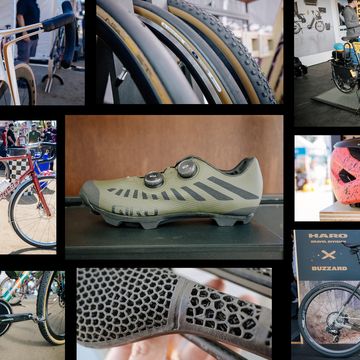Walk into any bike shop or roll out on any group ride and you’ll see that disc brakes are making serious gains in road bikes. The reasons are seemingly clear: disc brakes offer more controlled, consistent braking in variable weather conditions and open the door to wider tire options than traditional rim brakes. The one hardcore holdout? Top level pro racing, where rim brakes still dominate. After several years of speculation and even controversy, widespread change might finally come in 2018. And you might see it as soon as this month at the season-opening Tour Down Under.
Trek-Segafredo will use the new Emonda Disc platform in most races for 2018, the team said, including three-week Grand Tours like the Tour de France and Giro d’Italia. “Everyone who was on an Emonda rim-brake bike in 2017 will be on a disc-brake bike in 2018 in every race,” Trek team liaison Matt Shriver told CyclingNews. (Shriver was out of office Tuesday and unavailable for comment to Bicycling.)
The UCI's WorldTour has officially been in a disc brake trial since the 2016 season. But use has been sparse, and mostly in races like Paris-Roubaix where the added tire clearance is a bonus, or in early season stage races like Paris-Nice. Come showtime in May and July for the big tours, and discs were almost nowhere in the pro peloton.
That would seem to make Trek-Segafredo the outlier, but they’re not alone. Sources with the Katusha team say that the team plans to race disc brakes more in 2018, and Giant representatives predict that the Sunweb team of Giro d’Italia winner Tom Dumoulin will likely spend more time on the disc versions of bikes like the TCR and Propel this coming season. Women’s WorldTour team Canyon-SRAM will race only on discs for 2018.
What changed? Several factors are playing a role:
Results: Can't Argue with Success
Everyone likes a winner and pros started winning big races on disc brakes last year. Tom Boonen nabbed the first pro win on disc brakes during Stage 2 of Argentina’s Vuelta San Juan last January. Months later, Boonen’s teammate, Marcel Kittel, became the first rider to win a stage of the Tour de France on disc brakes when he took Stage 2 on a Specialized Venge ViAS Disc. He followed up with three more stage wins on the same bike.
Wins on discs weren’t widespread, but Kittel’s victories in particular establish credibility for the technology. A similar dynamic played out three seasons ago in cyclocross, where only a few riders had adopted discs, but one was Mathieu van der Poel, who won the World Championship on them. Fast-forward to today, and disc brakes are standard in the field. So far, disc brakes in road racing are following that script: initial resistance leading to sporadic adoption followed by results, and finally, broader adoption.
Safety: Lack of Injuries Calm Sharp Edge Concerns
WorldTour riders have been highly critical about disc brakes, voicing concerns of sharp-edged rotors in crashes. But to the extent that discs have been used, the fears haven’t borne out. There have been just a handful of crashes where riders allege that disc brakes caused an injury and in two of them—Francisco Ventoso’s crash in the 2016 Paris-Roubaix and Owain Doull’s crash at last year’s Tour of Abu Dhabi—official review found no evidence that discs caused their injuries (video from Doull’s crash suggests it was a fence). And no, discs will not really cut a shoe (a contention made by Sky's Owain Doull after a crash in last year's Abu Dhabi Tour left a slice in his left shoe; experiments have shown that highly unlikely).
At the same time, there’s been only halting progress on fixes that would address safety concerns. The UCI now requires rotors to have a rounded edge profile. But rotor covers are still not required (or used even voluntarily). But gradually, disc brakes are being used in races without catastrophic results, which is blunting the safety criticisms.
Industry: Most of the Big Players are in the Disc Brake Game
Up until 2017, it was impossible for some teams to run disc brakes in pro races. Campagnolo, for instance, didn’t have a disc-brake version of its components, so teams like Lotto-Soudal and UAE Emirates had no disc option. And a number of bike makers hadn’t certified disc frames through the mandatory UCI approval process.
But this past May, Campagnolo finally came out with a hydraulic disc gruppo. And as of the latest-available (December) update of the UCI’s approved-frames document, only Lapierre (which sponsors FDJ) and Bianchi (which sponsors LottoNL-Jumbo) lack an approved disc version of their all-around racing platforms. BMC doesn't have an all around bike approved yet, but its Classics-oriented GF01 is cleared, and says its Team Machine SLR01 Disc will be on the approved list "soon." Lapierre and Bianchi are further behind; Bianchi hasn’t gotten its Infinito Disc approved, and there is no disc version of the Oltre XR4 yet; Lapierre hasn't submitted its Xelius SL 700 Disc. But 15 of 18 teams are now set for disc-brake frames and groups.
Weight: New Groups are Pro Level Light
Disc-brake bikes are typically heavier than their rim-brake counterparts. But that’s changing. Already, we’ve seen a number of disc-brake bikes that were within a pound of the UCI’s 14.96-pound minimum weight limit.
Now, they’re at or below it in some cases. One of the biggest factors is the long-awaited availability of Shimano’s new Dura-Ace 9100 group. The group was announced 18 months ago, but some parts, like the hydraulic levers, weren’t available until recently. Previously, Shimano didn’t have a Dura-Ace hydraulic disc brake and Dual Control shifter. The new 9170 levers are 138 grams—almost five full ounces—lighter than the R785 non-series levers they replace.
That helps make lighter bikes. Bicycling recently tested a Trek Emonda Disc with clincher wheels and 28mm tires that was at the weight limit in a 54cm; tubular wheels and tires would make it even lighter. Canyon’s Ultimate WMN Disc CF SLX is its lightest frame, rim or disc, period, and an XS tester we had was just 15.1 pounds with mid-range components. And while Specialized has yet to officially intro its new Tarmac Disc, the bike is already UCI-approved and is rumored to weigh under 15 pounds.
There are still challenges to overcome before disc brakes get widespread adoption in pro racing. Right now, speedy wheel changes are a big issue. And safety concerns have not been fully addressed. So WorldTour racers—and some mechanics—are still largely taking a skeptical view of disc brakes.
But the weight penalty is quickly becoming a non-issue (at least unless the UCI decides to lower the current weight limit). And riders will continue to face tricky situations where the speed modulation of disc brakes is a benefit, like the descent of the Mont du Chats in last year’s Tour, where slick roads helped cause Richie Porte to crash out. All the pieces are finally in place for disc brakes to roll out more broadly. Now, it’s just down to the riders to choose. And 2018 might go down as the year that discs finally took hold in pro racing.
Joe Lindsey is a longtime freelance journalist who writes about sports and outdoors, health and fitness, and science and tech, especially where the three elements in that Venn diagram overlap.
